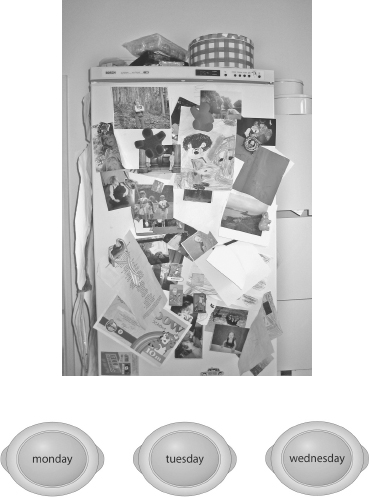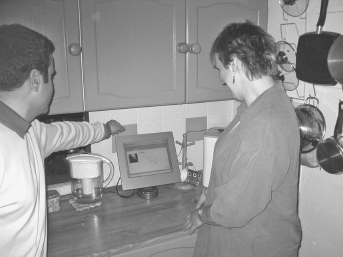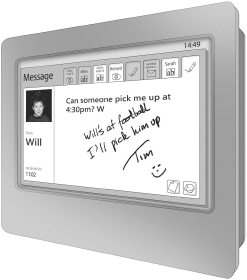The Design of Future Things (16 page)
Read The Design of Future Things Online
Authors: Don Norman

Before you know it, your home will expand its domain, recommending articles or television shows it thinks might interest you. Is this how you want to lead your life? Many researchers apparently think so. This is the approach followed by most developers of smart homes in research facilities at universities and industrial research laboratories around the world. It is all very efficient, all very modern, and most unhuman.
The research team in Microsoft's Cambridge laboratories started with the premise that people make homes smart, not technology. They decided to support each particular family's solution to their own needs, not to automate any one solution. The team spent time doing what's known as
ethnographic research
, observing home dwellers, watching real, everyday behavior. The goal is not to get in the way, not to change anything that is happening, but to be unobtrusive, simply watching and recording how people go about their normal activities.
A comment about research methods: you probably think that if a crew of scientists showed up at your home with voice recorders, cameras, and video camcorders, they could hardly be
considered unobtrusive. In fact, the typical family adapts to experienced researchers and goes about its usual business, including family squabbles and disagreements. This “applied ethnography,” or “rapid ethnography,” is different from the ethnographic work of anthropologists who spend years in exotic locations carefully observing a group's behavior. When applied scientists, engineers, and designers study the culture of the modern household in order to provide assistance, the goal is first to discover the places where people have difficulties, then to determine things that might aid them in those places. For this purpose, the designers are looking for large phenomena, major points of frustration or annoyance, where simple solutions can have a major, positive effect. This approach has been quite successful.
Family members communicate with one another through a wide variety of means. They write messages and notes that they leave wherever they think they might be noticedâon chairs, desktops, and computer keyboards, pasted on computer screens, or placed on stairs, beds, or doors. Because the kitchen has become the central gathering point for many families, one of the most common places to post notices is on the refrigerator. Most refrigerators are made of steel, and steel affords a hold for magnets. The original discoverers of magnets would be amazed to see that in today's home, the major use of magnets is to affix notes and announcements, children's drawings, and photographs to the front and sides of the refrigerator. This has spawned a small industry that makes refrigerator magnets, clips, notepads, frames for photos and pens, all to be fastened to the doors and sides.
Expensive refrigerators are often made of stainless steel, or the door is covered with wood paneling, thus destroying the affordance: magnets don't stick. When this happened to me, my initial reaction was annoyance to discover that an unintended consequence of the move to wood was the loss of my home communication center. Post-it notes still work but are aesthetically unacceptable on such appliances. Fortunately, entrepreneurs have rushed to fill the void, creating bulletin boards that can be mounted more discretely in the kitchen, and some of these have steel surfaces that provide a receptive home for magnets.
The very popularity of the refrigerator creates a problem, as you can see in
Figure 5.1
. Too many announcements, photographs, and newspaper clippings make it difficult to tell when a new item has been added. In addition, the refrigerator is not always the most appropriate place for either the note sender or its intended recipient. The Microsoft team developed a series of “augmented” note devices, which included a set of “reminding magnets.” One form of magnet glows gently for a period after being moved, drawing people's attention to the notice underneath. Another set of magnets is labeled by the day of the week, each of which glows subtly when the specific day has arrived, attracting attention without being bothersome. Thus, the “garbage pickup is Wednesday morning” magnet can be pinned to the refrigerator with the Tuesday magnet.
The fixed location of the refrigerator was overcome through cellular and internet technology. The team devised the notepad shown in
Figure 5.2A
. It can be placed in the kitchen adjacent to the refrigerator (or anywhere in the house, for that matter) and
allows messages to be added from anywhere through e-mail or a cell phone's text-messaging facility. Thus, the message board can display short messages, either to specific family members or to everyone. These messages can be posted either by handwriting, using a stylus on the display screen, sending an e-mail, or text-messaging from a mobile telephone (e.g., “Stuck in meetingâstart dinner without me”).
Figure 5.2B
shows the message pad in action. One of the family's children, Will, has sent a text message asking to be picked up. He sent it to the central message board rather than to any particular person because he didn't know who might be available. Tim responded, adding a handwritten note so that other family members will know that the situation is being taken care of. This system accomplishes its goal of making people smarter by providing them with the tools they need but still letting them decide if, when, and how to make use of this assistance.

F
IGURE
5.1
The refrigerator and “reminding magnets” studied by the Microsoft Research group at Cambridge, England. The top photograph is a typical refrigerator door being used as a bulletin board. When there are so many notes, it is difficult to find the relevant ones. The bottom picture shows the smart magnets: Put the “wednesday” magnet over the note relevant to that day, and when Wednesday comes, the magnet starts glowing, reminding without annoying.
(Photographs courtesy of the Socio-Digital Systems Group,
Microsoft Research Cambridge)
Other experimental smart homes have showcased a variety of related approaches. Imagine that you are in the middle of preparing to bake a cake when the telephone rings. You answer the phone, but when you return, how do you know where you left off? You recall adding flour to the bowl but aren't sure how many scoops. In the Georgia Institute of Technology's Aware Home, the “Cooks Collage” acts as a reminder. A television camera at the bottom of a cupboard photographs the cooking actions, displaying the steps taken. If you are interrupted in the middle of cooking, the display shows images of the last actions performed so you can readily remind yourself where you were. The philosophy here is very similar to that behind Microsoft's
work: augmentative technology should be voluntary, friendly, and cooperative. Use it or ignore it, as you wish.

F
IGURE
5.2
Microsoft Research kitchen display. A: The display can be put anywhere, here shown in the kitchen. B: One of the children (Will) has sent a text message from his mobile phone to the message center asking to be picked up (but not saying where he is). Another family member, Tim, has responded, using a stylus to write a note on the display so the rest of the family knows what is happening.
(Photographs courtesy of the Socio-Digital Systems Group,
Microsoft Research Cambridge)

Notice the important distinction between the devices of the Cambridge and Georgia Tech projects and those of the traditional smart home. Both groups of researchers could have tried to make the devices intelligent. In Cambridge, they could have made them sense who was in the room and change the displays accordingly, or they could have tried to read people's diaries and calendars, deciding for themselves what events to remind them of, what time they should be leaving the home for their next appointment. This is, indeed, a common preoccupation of researchers in the smart home field. Similarly, the researchers in Atlanta could have made an artificially intelligent assistant that read recipes, prompting and instructing every step of the way, or perhaps even an automated device that would make the cake itself. Instead, both groups devised systems that would fit smoothly into people's life styles. Both systems rely upon powerful, advanced technology, but the guiding philosophy for each group is augmentation, not automation.
The examples of smart homes show two different directions in which research on smart things can move. One is toward intelligent autonomy, systems that attempt to infer the intentions of people. The other is toward intelligent augmentation, providing useful tools but letting people decide when and where they are to be used. Both systems have their merits, and both have their problems.
Augmentative tools are comforting, for they leave the decisions about activities to people. Thus, we can take them or leave them, choosing those that we feel aid our lives, ignoring those that do not. Moreover, because these are voluntary, different people can make different choices, so that people can choose whatever mix of technology suits their life style.
Autonomous devices can be useful when jobs are dull, dangerous, or dirty. Autonomous tools are useful when the task otherwise could not be accomplished. Consider search-and-rescue missions in dangerous situations, for example, into the rubble of buildings after major earthquakes, fires, or explosions. Moreover, in situations where people could do the task, it is often very nice when someone else does the work for us, even when that someone else is a machine.
Still, some tasks are simply not yet ready to be automated. “Automation always looks good on paper. . . . Sometimes you need real people,” read the headline of a
New York Times
article commenting on the Denver, Colorado, airport's failed attempt to get its automated baggage-handling system to work properly. This system, the article claimed, “immediately became famous for its ability to mangle or misplace a good portion of everything that wandered into its path.” After ten years of trying and the expenditure of hundreds of millions of dollars, the airport gave up and dismantled the system.
The Denver airport serves as an example of an automation attempt that seemed straightforward on paper but was made before the technology was up to the task. People's baggage comes in a wide assortment of shapes. It is placed arbitrarily on the luggage system's conveyer belts, then must be shuffled to many
different connecting flights or baggage-delivery systems. The destination is marked by bar codes on the luggage tags, but those tags are bent, folded, and mutilated and are often hidden beneath handles, straps, or other luggage. This task has far too many irregularities and unknowns to be handled by today's systems.
Note that the airport shuttle trains that convey passengers between terminals at this same airport are completely automated and work smoothly and efficiently. The difference lies in the environment and the task, not the intelligence of the machines. With luggage, every piece is unique. With an airport shuttle, the route is completely fixed and predetermined. The train runs on tracks, so no steering is required. It can only move along the track, so the system only has to determine when it should move and how quickly. Simple sensors suffice to determine if anyone is standing in a doorway. When conditions are stable and the task well understood, when no mechanical agility is required and the unexpected happens infrequently, then automation can indeed take over. In these cases, automation works smoothly and efficiently and benefits everyone.